Kevin Jamieson
First-Order Regret in Reinforcement Learning with Linear Function Approximation: A Robust Estimation Approach
Dec 07, 2021Abstract:Obtaining first-order regret bounds -- regret bounds scaling not as the worst-case but with some measure of the performance of the optimal policy on a given instance -- is a core question in sequential decision-making. While such bounds exist in many settings, they have proven elusive in reinforcement learning with large state spaces. In this work we address this gap, and show that it is possible to obtain regret scaling as $\mathcal{O}(\sqrt{V_1^\star K})$ in reinforcement learning with large state spaces, namely the linear MDP setting. Here $V_1^\star$ is the value of the optimal policy and $K$ is the number of episodes. We demonstrate that existing techniques based on least squares estimation are insufficient to obtain this result, and instead develop a novel robust self-normalized concentration bound based on the robust Catoni mean estimator, which may be of independent interest.
Best Arm Identification with Safety Constraints
Nov 23, 2021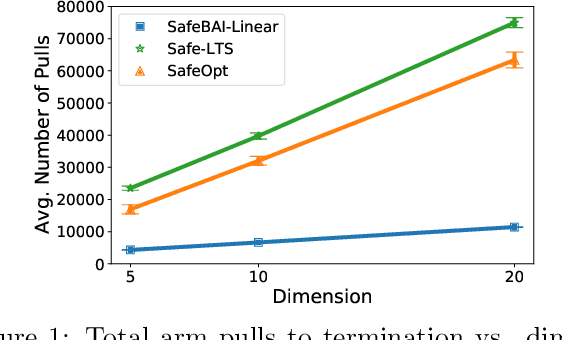
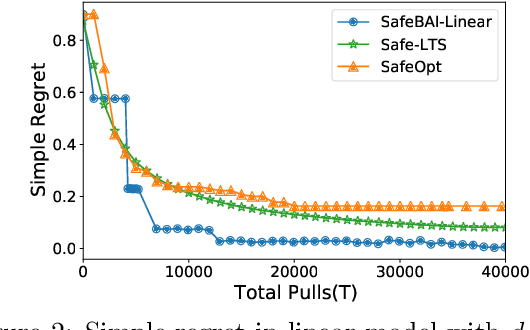
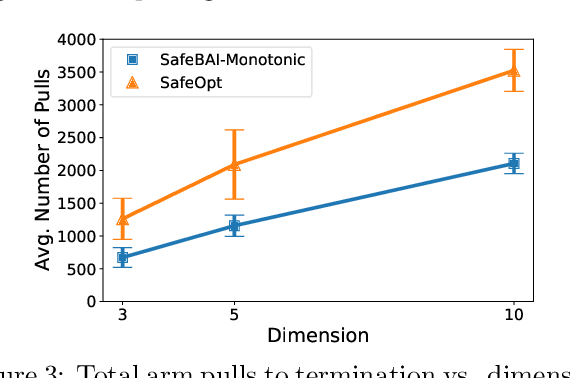
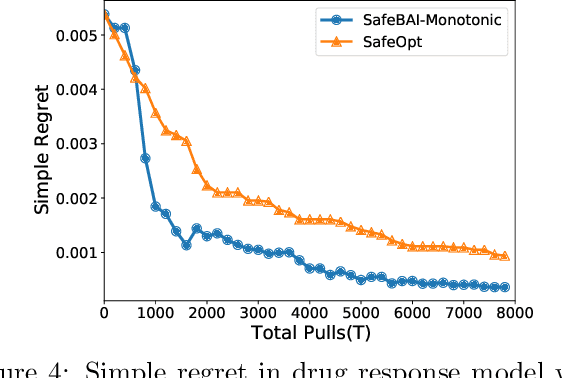
Abstract:The best arm identification problem in the multi-armed bandit setting is an excellent model of many real-world decision-making problems, yet it fails to capture the fact that in the real-world, safety constraints often must be met while learning. In this work we study the question of best-arm identification in safety-critical settings, where the goal of the agent is to find the best safe option out of many, while exploring in a way that guarantees certain, initially unknown safety constraints are met. We first analyze this problem in the setting where the reward and safety constraint takes a linear structure, and show nearly matching upper and lower bounds. We then analyze a much more general version of the problem where we only assume the reward and safety constraint can be modeled by monotonic functions, and propose an algorithm in this setting which is guaranteed to learn safely. We conclude with experimental results demonstrating the effectiveness of our approaches in scenarios such as safely identifying the best drug out of many in order to treat an illness.
Practical, Provably-Correct Interactive Learning in the Realizable Setting: The Power of True Believers
Nov 09, 2021
Abstract:We consider interactive learning in the realizable setting and develop a general framework to handle problems ranging from best arm identification to active classification. We begin our investigation with the observation that agnostic algorithms \emph{cannot} be minimax-optimal in the realizable setting. Hence, we design novel computationally efficient algorithms for the realizable setting that match the minimax lower bound up to logarithmic factors and are general-purpose, accommodating a wide variety of function classes including kernel methods, H{\"o}lder smooth functions, and convex functions. The sample complexities of our algorithms can be quantified in terms of well-known quantities like the extended teaching dimension and haystack dimension. However, unlike algorithms based directly on those combinatorial quantities, our algorithms are computationally efficient. To achieve computational efficiency, our algorithms sample from the version space using Monte Carlo "hit-and-run" algorithms instead of maintaining the version space explicitly. Our approach has two key strengths. First, it is simple, consisting of two unifying, greedy algorithms. Second, our algorithms have the capability to seamlessly leverage prior knowledge that is often available and useful in practice. In addition to our new theoretical results, we demonstrate empirically that our algorithms are competitive with Gaussian process UCB methods.
Nearly Optimal Algorithms for Level Set Estimation
Nov 02, 2021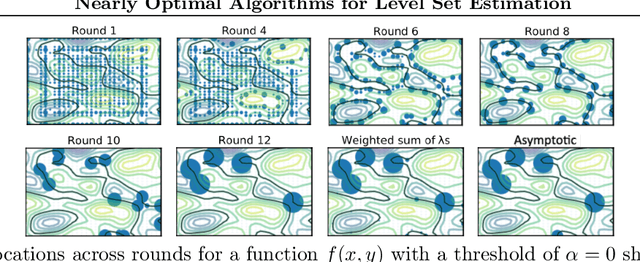


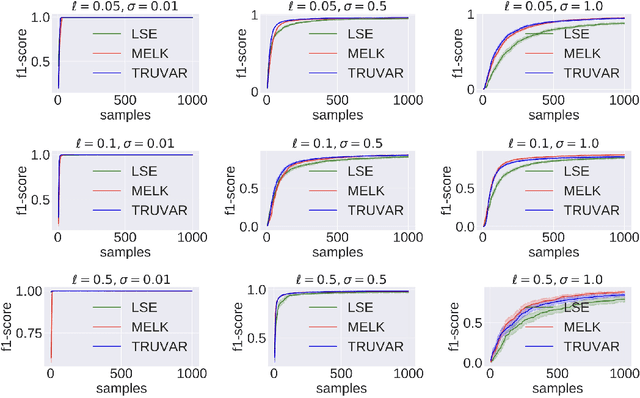
Abstract:The level set estimation problem seeks to find all points in a domain ${\cal X}$ where the value of an unknown function $f:{\cal X}\rightarrow \mathbb{R}$ exceeds a threshold $\alpha$. The estimation is based on noisy function evaluations that may be acquired at sequentially and adaptively chosen locations in ${\cal X}$. The threshold value $\alpha$ can either be \emph{explicit} and provided a priori, or \emph{implicit} and defined relative to the optimal function value, i.e. $\alpha = (1-\epsilon)f(x_\ast)$ for a given $\epsilon > 0$ where $f(x_\ast)$ is the maximal function value and is unknown. In this work we provide a new approach to the level set estimation problem by relating it to recent adaptive experimental design methods for linear bandits in the Reproducing Kernel Hilbert Space (RKHS) setting. We assume that $f$ can be approximated by a function in the RKHS up to an unknown misspecification and provide novel algorithms for both the implicit and explicit cases in this setting with strong theoretical guarantees. Moreover, in the linear (kernel) setting, we show that our bounds are nearly optimal, namely, our upper bounds match existing lower bounds for threshold linear bandits. To our knowledge this work provides the first instance-dependent, non-asymptotic upper bounds on sample complexity of level-set estimation that match information theoretic lower bounds.
Selective Sampling for Online Best-arm Identification
Nov 02, 2021
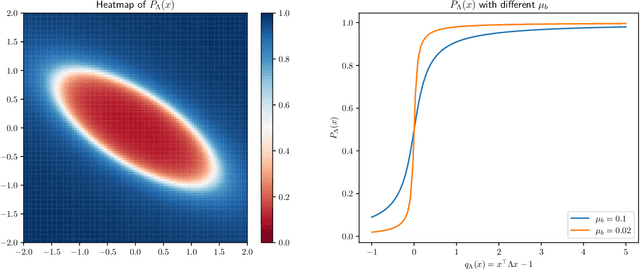
Abstract:This work considers the problem of selective-sampling for best-arm identification. Given a set of potential options $\mathcal{Z}\subset\mathbb{R}^d$, a learner aims to compute with probability greater than $1-\delta$, $\arg\max_{z\in \mathcal{Z}} z^{\top}\theta_{\ast}$ where $\theta_{\ast}$ is unknown. At each time step, a potential measurement $x_t\in \mathcal{X}\subset\mathbb{R}^d$ is drawn IID and the learner can either choose to take the measurement, in which case they observe a noisy measurement of $x^{\top}\theta_{\ast}$, or to abstain from taking the measurement and wait for a potentially more informative point to arrive in the stream. Hence the learner faces a fundamental trade-off between the number of labeled samples they take and when they have collected enough evidence to declare the best arm and stop sampling. The main results of this work precisely characterize this trade-off between labeled samples and stopping time and provide an algorithm that nearly-optimally achieves the minimal label complexity given a desired stopping time. In addition, we show that the optimal decision rule has a simple geometric form based on deciding whether a point is in an ellipse or not. Finally, our framework is general enough to capture binary classification improving upon previous works.
Beyond No Regret: Instance-Dependent PAC Reinforcement Learning
Aug 05, 2021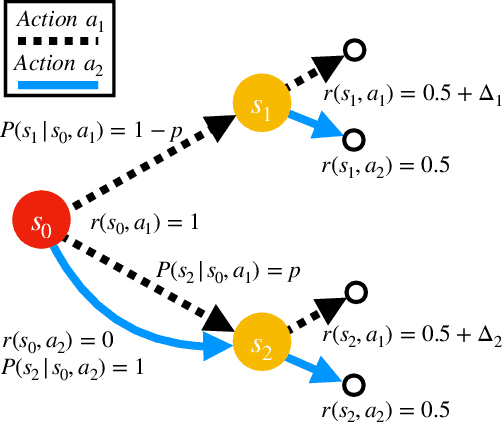
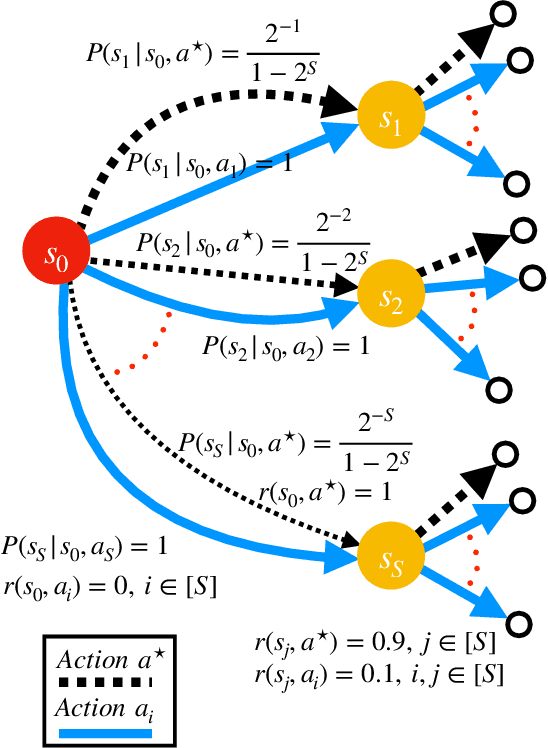
Abstract:The theory of reinforcement learning has focused on two fundamental problems: achieving low regret, and identifying $\epsilon$-optimal policies. While a simple reduction allows one to apply a low-regret algorithm to obtain an $\epsilon$-optimal policy and achieve the worst-case optimal rate, it is unknown whether low-regret algorithms can obtain the instance-optimal rate for policy identification. We show that this is not possible -- there exists a fundamental tradeoff between achieving low regret and identifying an $\epsilon$-optimal policy at the instance-optimal rate. Motivated by our negative finding, we propose a new measure of instance-dependent sample complexity for PAC tabular reinforcement learning which explicitly accounts for the attainable state visitation distributions in the underlying MDP. We then propose and analyze a novel, planning-based algorithm which attains this sample complexity -- yielding a complexity which scales with the suboptimality gaps and the ``reachability'' of a state. We show that our algorithm is nearly minimax optimal, and on several examples that our instance-dependent sample complexity offers significant improvements over worst-case bounds.
Corruption Robust Active Learning
Jun 21, 2021Abstract:We conduct theoretical studies on streaming-based active learning for binary classification under unknown adversarial label corruptions. In this setting, every time before the learner observes a sample, the adversary decides whether to corrupt the label or not. First, we show that, in a benign corruption setting (which includes the misspecification setting as a special case), with a slight enlargement on the hypothesis elimination threshold, the classical RobustCAL framework can (surprisingly) achieve nearly the same label complexity guarantee as in the non-corrupted setting. However, this algorithm can fail in the general corruption setting. To resolve this drawback, we propose a new algorithm which is provably correct without any assumptions on the presence of corruptions. Furthermore, this algorithm enjoys the minimax label complexity in the non-corrupted setting (which is achieved by RobustCAL) and only requires $\tilde{\mathcal{O}}(C_{\mathrm{total}})$ additional labels in the corrupted setting to achieve $\mathcal{O}(\varepsilon + \frac{C_{\mathrm{total}}}{n})$, where $\varepsilon$ is the target accuracy, $C_{\mathrm{total}}$ is the total number of corruptions and $n$ is the total number of unlabeled samples.
Improved Algorithms for Agnostic Pool-based Active Classification
May 13, 2021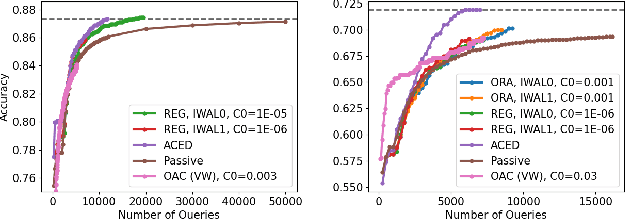

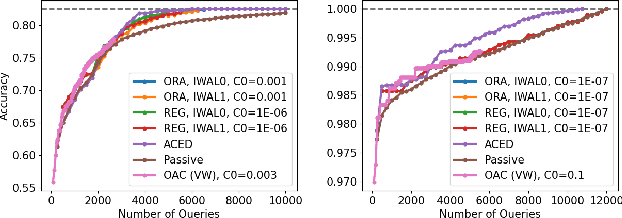
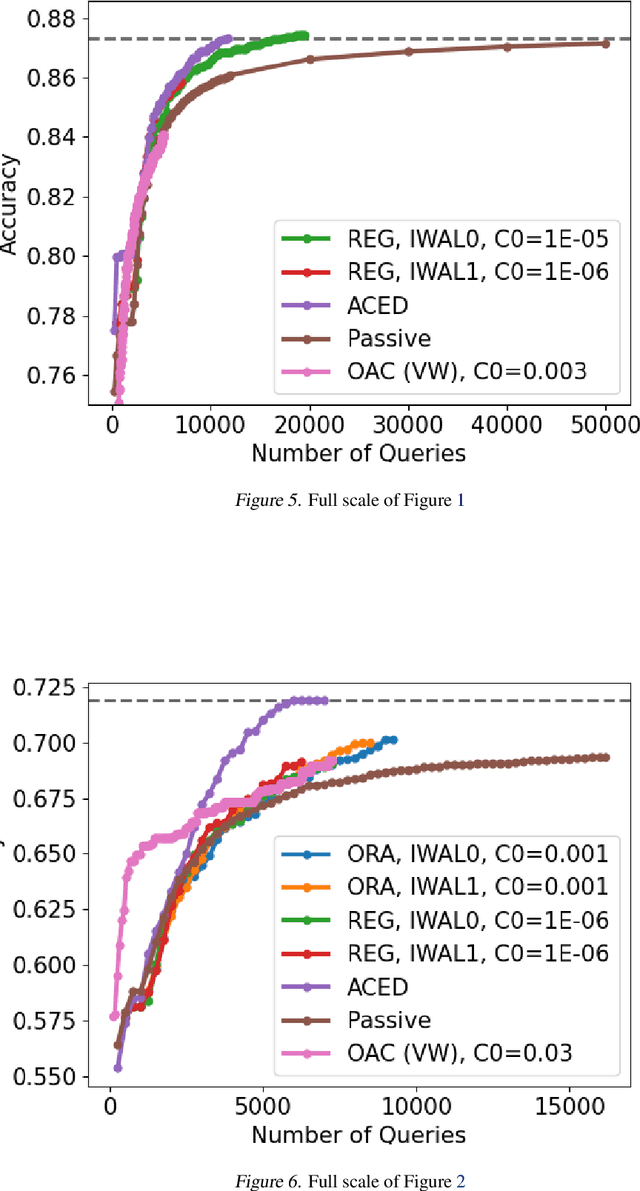
Abstract:We consider active learning for binary classification in the agnostic pool-based setting. The vast majority of works in active learning in the agnostic setting are inspired by the CAL algorithm where each query is uniformly sampled from the disagreement region of the current version space. The sample complexity of such algorithms is described by a quantity known as the disagreement coefficient which captures both the geometry of the hypothesis space as well as the underlying probability space. To date, the disagreement coefficient has been justified by minimax lower bounds only, leaving the door open for superior instance dependent sample complexities. In this work we propose an algorithm that, in contrast to uniform sampling over the disagreement region, solves an experimental design problem to determine a distribution over examples from which to request labels. We show that the new approach achieves sample complexity bounds that are never worse than the best disagreement coefficient-based bounds, but in specific cases can be dramatically smaller. From a practical perspective, the proposed algorithm requires no hyperparameters to tune (e.g., to control the aggressiveness of sampling), and is computationally efficient by means of assuming access to an empirical risk minimization oracle (without any constraints). Empirically, we demonstrate that our algorithm is superior to state of the art agnostic active learning algorithms on image classification datasets.
High-Dimensional Experimental Design and Kernel Bandits
May 12, 2021
Abstract:In recent years methods from optimal linear experimental design have been leveraged to obtain state of the art results for linear bandits. A design returned from an objective such as $G$-optimal design is actually a probability distribution over a pool of potential measurement vectors. Consequently, one nuisance of the approach is the task of converting this continuous probability distribution into a discrete assignment of $N$ measurements. While sophisticated rounding techniques have been proposed, in $d$ dimensions they require $N$ to be at least $d$, $d \log(\log(d))$, or $d^2$ based on the sub-optimality of the solution. In this paper we are interested in settings where $N$ may be much less than $d$, such as in experimental design in an RKHS where $d$ may be effectively infinite. In this work, we propose a rounding procedure that frees $N$ of any dependence on the dimension $d$, while achieving nearly the same performance guarantees of existing rounding procedures. We evaluate the procedure against a baseline that projects the problem to a lower dimensional space and performs rounding which requires $N$ to just be at least a notion of the effective dimension. We also leverage our new approach in a new algorithm for kernelized bandits to obtain state of the art results for regret minimization and pure exploration. An advantage of our approach over existing UCB-like approaches is that our kernel bandit algorithms are also robust to model misspecification.
Improved Corruption Robust Algorithms for Episodic Reinforcement Learning
Mar 08, 2021Abstract:We study episodic reinforcement learning under unknown adversarial corruptions in both the rewards and the transition probabilities of the underlying system. We propose new algorithms which, compared to the existing results in (Lykouris et al., 2020), achieve strictly better regret bounds in terms of total corruptions for the tabular setting. To be specific, firstly, our regret bounds depend on more precise numerical values of total rewards corruptions and transition corruptions, instead of only on the total number of corrupted episodes. Secondly, our regret bounds are the first of their kind in the reinforcement learning setting to have the number of corruptions show up additively with respect to $\min\{\sqrt{T}, \text{PolicyGapComplexity}\}$ rather than multiplicatively. Our results follow from a general algorithmic framework that combines corruption-robust policy elimination meta-algorithms, and plug-in reward-free exploration sub-algorithms. Replacing the meta-algorithm or sub-algorithm may extend the framework to address other corrupted settings with potentially more structure.
 Add to Chrome
Add to Chrome Add to Firefox
Add to Firefox Add to Edge
Add to Edge